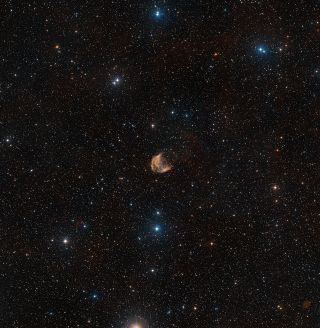Stunning 'Snakes' of Medusa Nebula Hint at Sun's Fate (Video, Photos)

The Medusa Nebula's most detailed close-up ever shows a dying star's fate, similar to what will befall our sun in a few million years.
The colorful display of gas some 1,500 light-years from Earth is happening because a star in the center of the nebula is shedding its outer layers into space. The new images and a stunning video of the Medusa Nebula were created by astronomers with European Southern Observatory. Called a "planetary nebula", this is a common fate for stars that are about the size of our sun.
The gas will persist for a few tens of thousands of years until it moves away, leaving behind a cold remnant of the star, called a white dwarf. Astronomers captured the image using ESO's Very Large Telescope in Chile. [Video: How the Sun Will Die]
"Medusa was a hideous creature with snakes in place of hair. These snakes are represented by the serpentine filaments of glowing gas in this nebula," wrote the European Southern Observatory of the image.
"The red glow from hydrogen and the fainter green emission from oxygen gas extends well beyond this frame, forming a crescent shape in the sky," ESO officials wrote in a description. "The ejection of mass from stars at this stage of their evolution is often intermittent, which can result in fascinating structures within planetary nebulae."
Planetary nebulas are characterized by a particular form of glowing gas called doubly ionized oxygen. The gas is excited by ultraviolet radiation emanating from the star, which strips away electrons from the gas.

The Medusa Nebula is also called Abell 21 after the American astronomer George O. Abell, who found it in 1955. At first, astronomers thought that perhaps it could be leftovers of a supernova explosion, but measurements of the gas in the 1970s showed that it actually comes from a dying star.
Get the Space.com Newsletter
Breaking space news, the latest updates on rocket launches, skywatching events and more!
The nebula, which is in the constellation Gemini, is about 4 light-years across.
Follow Elizabeth Howell @howellspace. Follow us @Spacedotcom, Facebook and Google+. Original article on Space.com.
Join our Space Forums to keep talking space on the latest missions, night sky and more! And if you have a news tip, correction or comment, let us know at: community@space.com.

Elizabeth Howell (she/her), Ph.D., is a staff writer in the spaceflight channel since 2022 covering diversity, education and gaming as well. She was contributing writer for Space.com for 10 years before joining full-time. Elizabeth's reporting includes multiple exclusives with the White House and Office of the Vice-President of the United States, an exclusive conversation with aspiring space tourist (and NSYNC bassist) Lance Bass, speaking several times with the International Space Station, witnessing five human spaceflight launches on two continents, flying parabolic, working inside a spacesuit, and participating in a simulated Mars mission. Her latest book, "Why Am I Taller?", is co-written with astronaut Dave Williams. Elizabeth holds a Ph.D. and M.Sc. in Space Studies from the University of North Dakota, a Bachelor of Journalism from Canada's Carleton University and a Bachelor of History from Canada's Athabasca University. Elizabeth is also a post-secondary instructor in communications and science at several institutions since 2015; her experience includes developing and teaching an astronomy course at Canada's Algonquin College (with Indigenous content as well) to more than 1,000 students since 2020. Elizabeth first got interested in space after watching the movie Apollo 13 in 1996, and still wants to be an astronaut someday. Mastodon: https://qoto.org/@howellspace
